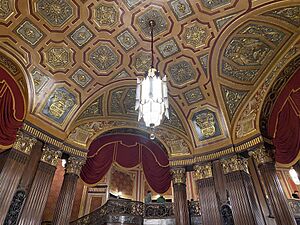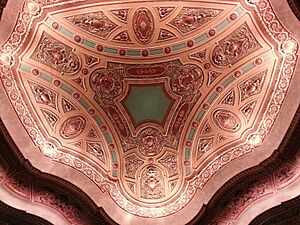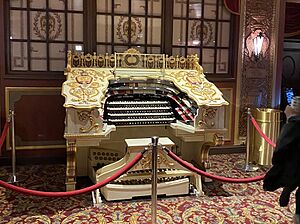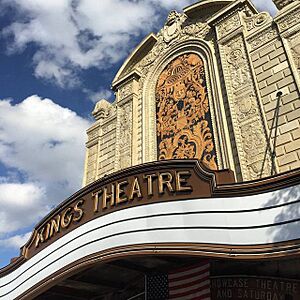Kings Theatre (Brooklyn) facts for kids
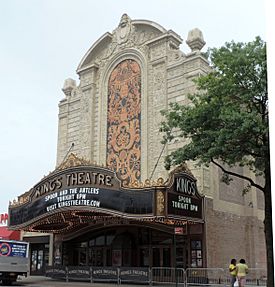
Renovated facade (2015)
|
|
| Address | 1027 Flatbush Avenue Brooklyn, New York United States |
|---|---|
| Owner | New York City Economic Development Corporation Loew's Theatres (1929–1977) |
| Operator | Ambassador Theatre Group |
| Type | Movie palace |
| Capacity | 3,250 |
| Current use | Entertainment venue |
| Construction | |
| Opened | September 7, 1929 |
| Rebuilt | 2013–2015 |
| Years active | 1929–1977 2015–present |
| Architect | Rapp and Rapp Martinez & Johnson (restoration) |
|
Loew's Kings Theatre
|
|
| Location | 1027 Flatbush Avenue Brooklyn, New York City |
| Built | 1929 |
| Architectural style | French Baroque |
| NRHP reference No. | 12000534 |
| Added to NRHP | August 22, 2012 |
The Kings Theatre (also known as Loew's Kings Theatre) is a beautiful old theater in the Flatbush area of Brooklyn, New York City. It's located at 1027 Flatbush Avenue. This amazing building was designed by a company called Rapp and Rapp. It first opened its doors on September 7, 1929. Back then, it was one of five special "Wonder Theatres" built by Loew's Theatres in the New York City area.
The inside of the theater was decorated by Rapp and Rapp, along with Harold Rambusch. Today, the New York City Economic Development Corporation owns the Kings Theatre. Since 2015, the Ambassador Theatre Group has been in charge of running it. The Kings Theatre is so important that it's listed on the National Register of Historic Places.
The Kings Theatre has two main parts: a grand lobby and a huge auditorium. The lobby section has a fancy outside made of terracotta with a big sign, called a marquee, over the entrance. Inside, there are high-ceilinged lobbies and lounges. The auditorium has 3,250 seats on two levels. It has a very decorated arch around the stage, fancy walls, and ceilings. The Kings Theatre used to have a special "Wonder Morton" pipe organ, but it was removed a long time ago.
A theater was first planned for this spot in 1919. Later, in 1928, a company called Allied Owners Inc. started building the Kings Theatre. They then rented it to Loew's Theatres. The Kings Theatre first showed movies and live shows. But after about ten years, they stopped the live shows. After World War II, the theater became less popular and mostly just showed movies.
The Kings Theatre closed in August 1977 because it cost too much to run and not enough people were coming. For over 30 years, the theater was empty and slowly fell apart. Then, in 2013, ACE Theatrical Group rented the theater from the New York City Economic Development Corporation. They spent $95 million to fix it up! The theater reopened on January 23, 2015. Since then, the Kings Theatre has been a popular place for concerts and other events.
Contents
Exploring the Kings Theatre
The Loew's Kings Theatre was designed by the famous architectural firm Rapp and Rapp. They also designed two other theaters in New York City: the Brooklyn Paramount and the Times Square Paramount. The Kings Theatre was one of five special "Wonder Theatres" in the New York City area. The other four were the Jersey Theatre in Jersey City, the 175th Street Theatre in Manhattan, the Paradise Theatre in the Bronx, and the Valencia Theatre in Queens. Rapp and Rapp wanted the theater's fancy design to make everyone who visited feel special.
The theater is located at 1027 Flatbush Avenue in the Flatbush neighborhood of Brooklyn, New York City. It sits in the middle of a city block. The Kings Theatre has an unusual shape and is split into two main parts: the lobby and the auditorium. The main entrance faces Flatbush Avenue.
Outside the Theatre
The front of the theater, facing Flatbush Avenue, is about 40 feet tall. It's the only part of the outside that has a lot of decoration.
The Flatbush Avenue Entrance
The main entrance has a curved archway with brass and glass doors. Above the doors, there's a fancy sign that welcomes visitors. The doors are set back a little, and a bronze ticket booth sticks out in the middle. Above the entrance is a large marquee (the big sign with lights). This marquee was restored in the 2010s and now has the theater's name and 800 light bulbs.
The rest of the front of the building above the marquee is covered in cream-colored architectural terracotta. It has three vertical sections. The middle section has a detailed carving, called a bas-relief, with designs like leaves, birds, and masks. This carving is surrounded by a curved arch. On each side of the arch, there are decorated columns, called pilasters, with more carvings.
Inside the Theatre
The inside of the theater was designed by Harold Rambusch, who worked with Rapp & Rapp. The decorations were inspired by famous buildings like the Paris Opera House and the Palace of Versailles. The theater has two main levels above ground, plus a basement. Inside, you'll find an entrance area, a main lobby, an inner lobby, several lounges, and the main auditorium.
Vestibule and Lobbies
Right after you enter, you step into a long entrance area called the vestibule. The walls here have marble panels and mirrors. The floor is made of concrete with rubber mats.
Beyond the vestibule is the main lobby, which is about 40 by 75 feet. The floor is made of pink and white marble tiles. The walls are 30 feet high. The lower parts are decorated with red marble, and the upper parts have walnut wood panels. The lobby has fancy wooden columns and arched sections with mirrors and painted decorations. The ceiling is made of plaster with detailed square and octagonal shapes. Three beautiful Art Deco chandeliers hang from the ceiling. Each one weighs about 1 ton!
The inner lobby is about 80 by 32 feet and extends from the main lobby. It has similar decorations. This area has a curved ceiling with more decorative shapes and four chandeliers.
Foyers and Lounges
Next to the inner lobby are foyers on both the ground floor (orchestra level) and the mezzanine level (a middle floor). These areas have simpler designs than the lobbies. The orchestra-level foyer is 30 feet wide and 185 feet long. From this foyer, you can find lounges for men and women, a cosmetic room, and a coat-check room. The women's lounge used to have marble fountains and a fireplace.
The mezzanine foyer is right above the orchestra foyer. It connects to the lounges and a projection room. The original projector in the projection room doesn't work anymore, so they use a digital one for movies. Three of the theater's lounges were fixed up in the 2010s and are now open to visitors.
The Auditorium
The auditorium is shaped like a rectangle and faces the stage. It's about 155 feet deep and 160 feet wide at the back. The ceiling is 90 feet tall. Unlike many theaters with several balconies, the Kings Theatre has only one balcony level. This was done to make the sound better. Both the main floor (orchestra) and the balcony slope down towards the stage. When the theater was fixed up in the 2010s, these slopes were changed to give everyone a better view.
The auditorium originally had 3,690 seats. After the 2010s renovation, the number of seats was reduced to 3,250. Even with fewer seats, the Kings Theatre is the fourth-largest live event venue in New York City as of 2015.
The stage is about 34 by 80 feet. The area in front of the stage, called the orchestra pit, can hold 40 musicians. About 300 seats near the stage can be removed to make space for people who want to stand during events.
Auditorium Design
The orchestra pit is surrounded by a fancy plaster and marble railing. The arch around the stage, called the proscenium arch, is 60 feet high and has beautiful decorations like leaves and flowers. On each side of the stage arch, there are special areas for the theater's organ equipment. The side walls of the auditorium are 50 feet high and have tall, decorated columns.
The underside of the balcony has fancy plaster designs. The back and side walls have more columns and curved arches with red and gold curtains. These arches lead to the seats on the mezzanine level. The ceiling is made of plaster and has colorful octagonal and square shapes. In the center of the ceiling is a special recessed panel. The top of the ceiling dome is 75 feet high and is decorated in red, gold, and blue.
The Wonder Morton Organ
Like the other Wonder Theatres, the Loew's Kings Theatre had a special "Wonder Morton" pipe organ. This organ had four keyboards and 23 sets of pipes. In total, there were 3,000 pipes! It cost $75,000 when the theater was built in 1929. The organ stayed in the theater until 1974. It was taken apart and was supposed to be moved to another location, but it was never put back together. Parts of it were even stolen.
In 2011, the original organ console (the part with the keyboards) was donated to the New York Theatre Organ Society. It was hoped that the organ would return to the Kings Theatre after its renovation. However, the renovation budget didn't include the $650,000 needed to move and reinstall the organ. In 2014, the theater's developers agreed to create an electronic version of the Wonder Morton sound.
History of the Kings Theatre
Movie palaces became very popular in the 1920s. These were huge, fancy theaters built to show movies. In New York City, only a few companies built these grand theaters. The five Wonder Theatres, including the Kings, were built by Loew's Inc.
Building and Opening
Before the Kings Theatre was built, the spot at 1027 Flatbush Avenue was a train yard. William Fox bought the land in 1919 and planned a theater, but it was never finished. Then, Allied Owners Inc. took over the site in 1927. The theater was named "Kings" because it's in Kings County, New York, which is the same as Brooklyn.
Construction of the Kings Theatre began in 1928. Workers quickly built the foundation, steel frame, and roof. By August 1929, the decorators were finishing the inside. The whole project cost $1.3 million. The Kings Theatre officially opened to the public at 11 a.m. on September 7, 1929. The first show included the film Evangeline, a live stage show, an orchestra, and the pipe organ. The movie's star, Dolores del Río, even made a special appearance!
How it Operated
When it first opened, the Loew's Kings Theatre showed new movies and live stage shows. It also hosted events like beauty pageants, fundraisers, and awards. Many high schools held their graduation ceremonies there because it was one of the few places in Brooklyn big enough. Famous people like U.S. Senator Chuck Schumer and musician Carole King had their graduations there. The theater also hosted Christmas parties for orphans and even bridge lessons.
In its early years, the balcony was so popular that it often filled up first. The theater had a large staff, including 18 ushers, doormen, cashiers, and engineers. Some famous people who worked there as ushers included Sylvester Stallone and Henry Winkler. There's a story that Barbra Streisand was an usher there too, but she actually just watched movies there often.
During the 1930s, many famous performers appeared at the Kings Theatre, including Gracie Allen, Milton Berle, George Burns, Cab Calloway, Jimmy Durante, and Bob Hope. Other celebrities like Chuck Berry, Marlon Brando, Eddie Cantor, and Little Richard also performed there over the years.
Decline and Closure
After World War II, the Kings Theatre slowly became less popular. It mostly showed movies. By the 1960s, Loew's Theatres started having money problems and closed some of its bigger theaters. People were also moving to the suburbs and watching movies at new multiplexes or on their televisions at home.
The theater's original pipe organ was played for the last time in 1974. In its final years, the Kings Theatre showed low-budget films, as well as action and horror movies. In 1976, a community leader named Marty Markowitz suggested turning the Kings Theatre into a place for big stage shows again.
The Kings Theatre closed for good on August 30, 1977. It couldn't stay open because of high costs and low attendance. The last movies shown there were Islands in the Stream and The Death of Bruce Lee.
Abandoned and Reborn
When the Kings Theatre closed, its inside was mostly still intact. A small team of people kept it maintained. Before it reopened in 2015, there were at least seven attempts to fix up the theater, but they all failed.
Attempts to Save the Theatre
1970s and 1980s Efforts
In 1978, Brooklyn's borough president, Howard Golden, set aside money to buy the Kings Theatre. He wanted to turn it into a cultural center. Another idea was to change it into a roller rink. The Flatbush Development Corporation (FDC) bought the theater for $780,000 and planned to spend $8 million to $10 million to make it a live-events venue. They even held a fundraiser at the theater in 1979, which was the first event there in two years. People also wanted the building to be named an official landmark.
The city government took over the theater in 1978 after the FDC didn't pay taxes. The city still wanted to renovate the theater. There were plans to connect it to nearby stores, but these plans were canceled because local small businesses worried about competition.
By 1982, the empty theater was being vandalized and falling apart. Squatters even moved into the building. Students from South Shore High School "adopted" the theater in 1985, learning about its history. The city then started looking for a company to renovate the Kings Theatre. In 1986, a group including the FDC and Save the Theatres Inc. announced plans to turn it into a performing-arts venue. The National Park Service said the theater was important enough to be a U.S. National Historic Landmark. The city government spent $200,000 to fix the roof in 1989.
1990s and 2000s Efforts
In 1990, the New York City Economic Development Corporation (EDC) asked for ideas to fix up the theater. It would cost at least $4.5 million just to make basic repairs. The city wanted the winning company to keep it as a theater. Two main ideas came forward: one to make it a community center for Caribbean-Americans, and another to divide it into a movie multiplex. These plans didn't happen.
In 1996, the city asked for new ideas again. Magic Johnson Theatres, owned by the famous basketball player Magic Johnson, offered to turn the theater into a 12-screen multiplex with a restaurant. The city liked this plan and chose Johnson's company in 1999. The renovation was supposed to cost $30 million, with the city providing $2.5 million. However, Johnson's renovation never started because of money problems.
The theater stayed empty through the 2000s. By the mid-2000s, the cost to restore it had grown to $35 million. The inside was badly damaged from neglect, water, and vandalism. There was also asbestos, lead, and mold. Part of the roof had even fallen in. The roof was repaired again in 2007 to stop more damage. In 2008, the city asked for new proposals for a $70 million renovation. Marty Markowitz, who was then the borough president, believed a live-event venue would help Flatbush's economy. He got $10.75 million from the city budget for the renovation.
The Big Renovation
Planning for the renovation started in 2009. In February 2010, New York City announced that ACE Theatrical Group would fix up the theater for $70 million. ACE had experience renovating other historic theaters. The city provided $50 million, ACE spent $5 million, and the rest came from tax credits. Martinez & Johnson were hired to design the restoration. Before work began, workers found a homeless person on the stage and saw how much the theater had decayed. One side of the auditorium was almost destroyed by water, and there were wild cats and birds inside.
The theater was added to the National Register of Historic Places in 2012. This helped the developers get money for preservation. Work officially began on January 23, 2013. By then, the cost had increased to $94 million. Workers cleaned up the site and installed a new roof. The theater was updated to meet modern building rules, and new lights were put in. The stage area at the back of the theater was made bigger. The slope of the auditorium seats was changed for better views, and the number of seats was reduced to 3,250. Bars were added, and the basement was made larger. ACE even spent over $75,000 to restore the original lobby furniture, which the theater's former manager had kept for 40 years!
The inside of the theater was restored to look just like it did originally. A company called EverGreene Architectural Arts was hired to fix the original decorations. Since most of the decorations had been stolen or damaged, EverGreene had to recreate many of them. They took samples to find the original colors and finishes. The damaged parts were repaired and cleaned, and the outside of the building and the marquee were also restored. The chandeliers in the lobbies, which were some of the few remaining original decorations, were rebuilt. The restoration was very complex and cost $95 million in total.
Reopening and Today
ACE started hiring staff for the theater in late 2014. Diana Ross was chosen as the first artist to perform at the reopening. The theater officially reopened on January 23, 2015, and Diana Ross gave a special performance on February 3. Besides performances, the theater also hosted community events and tours. Marty Markowitz predicted that the Kings Theatre would become "Brooklyn's Beacon and Apollo theaters all in one." People hoped the theater's reopening would help the local economy.
After it reopened, the Kings Theatre hosted many musical acts, including Jackson Browne, Josh Groban, and Yo La Tengo. It also held events like the National Beard & Moustache Championships. The theater's new management hired mostly people from the neighborhood and worked with local businesses. In September 2015, the Ambassador Theatre Group (ATG) bought ACE's theaters, including the Kings Theatre.
Billboard magazine wrote in 2018 that the theater had become a well-known place for live events in the New York area. Besides music concerts, it hosted events for different groups in Brooklyn, as well as boxing matches, family shows, and comedy shows. The theater was also used for private events like meetings and graduation ceremonies. The Kings Theatre temporarily closed in 2020 because of the COVID-19 pandemic in New York City. ATG started offering tours of the Kings Theatre again in 2023.
Impact of the Kings Theatre
How People Felt About It
When the theater first opened, the Brooklyn Eagle newspaper said that "luxury seems to have been the watchword of the designers." The Brooklyn Daily Times called the Kings Theatre "one of the most beautiful theatres anywhere." The Chat newspaper said it was "the most gorgeous blending of Old World decorative beauty and modern comfort." The New York Herald Tribune wrote in 1942 that theaters like the Kings brought a "new development in neighborhood entertainment" because they were so much larger than other local movie theaters.
After the theater closed, a writer for the New York Daily News called it "a seeming Sistine Chapel of class." Another reporter for the same paper described it as the Versailles of movie palaces. A New Yorker article said the Kings Theatre was "perhaps the single most ornate movie house in the country." In 2013, The Wall Street Journal described the Kings as one of several New York City theaters with "exteriors that loom large."
Media and Exhibitions
When the theater stopped showing movies, a director named Christian Blackwood made a documentary about it called Memoirs of a Movie Palace: Kings of Flatbush. This film came out in 1979 and included interviews with people who had worked at the theater for a long time. The abandoned theater was also used as a filming location for the movie Sophie's Choice in 1982, though the scene shot there was later removed from the film. Scenes from TV shows like So You Think You Can Dance, Gotham, and The Blacklist have also been filmed there.
Drawings of the theater's inside were shown in an exhibit at the Municipal Art Society in 1983. The Museum of the Moving Image also had an exhibition about the Loew's Kings and other Loew's theaters in 2004. The photographer Matt Lambros took pictures of the theater for his book After the Final Curtain in the early 2010s. Lambros and the Theatre Historical Society of America also published a book about the theater called Kings Theater: The Rise, Fall and Rebirth of Brooklyn's Wonder Theater in 2015.
See also
 In Spanish: Teatro Kings (Brooklyn) para niños
In Spanish: Teatro Kings (Brooklyn) para niños





